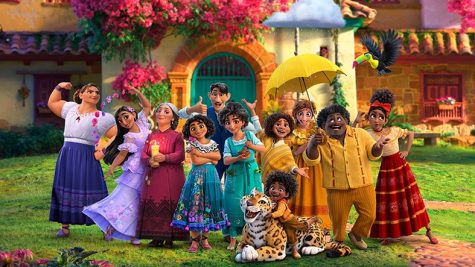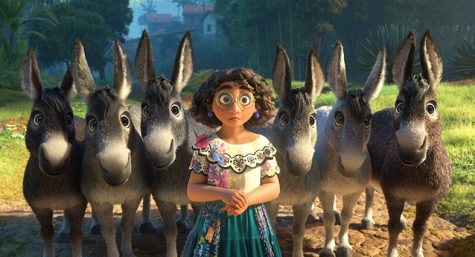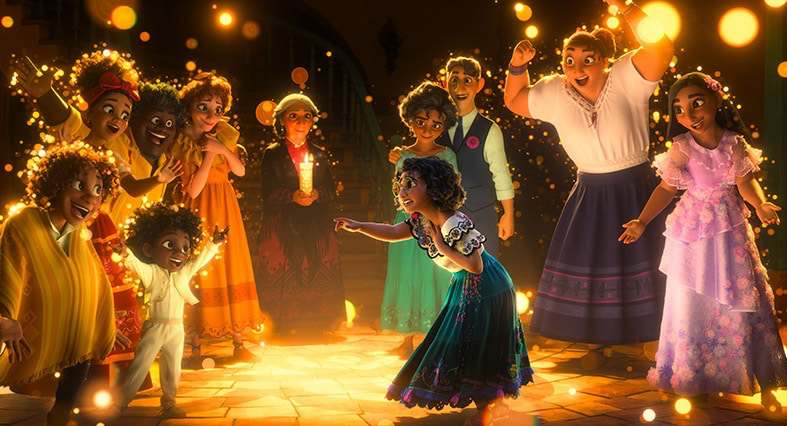Your donation will support the student journalists of Omaha Central High School. Your contribution will allow us to purchase equipment and cover our annual website hosting costs.
‘Encanto’ is a welcome change from Disney
A review of Disneys latest movie, Encanto, and the impact it’s had on viewers.
January 27, 2022
Disney’s latest movie release “Encanto” has broken records and left an effect on everyone from adults to toddlers. Encanto is a definite change from Disney’s mostly American appealing casts and shows that the company is ready to expand its borders, both literally and figuratively. This is the first movie with Latino representation that solely Disney has come out with, and fans are excited about it.
The movie takes place in a Colombian village named Encanto and revolves around the Madrigal family. The audience soon learns that this is not an ordinary town and that the Madrigals are a magical family.

Every direct family member (except the main character Maribel) has a magical gift that is exclusive to them. The family uses these powers to help the town flourish and run smoothly. But one day there is a disturbance within the magical Casita and panic fills the town and overtakes the family.
The family magic is held by a golden candle that was blessed by an unknown source when Abuela was running from people that overtook her hometown. After Abuela’s husband is killed by these men, the candle glows, and the town of Encanto rises from the ground.
A common conspiracy is that the grandfather is the one containing the magic and blessing the family, often appearing as a golden butterfly.
The beginning of the movie introduced the audience to all the characters and their powers in a song. The most noteworthy characters include Abuela, Antonio, Luisa, Isabella, Bruno, and my personal favorite, Maribel. Many fans have shown love for their favorite Madrigal, but a character that has been getting some hate is the misunderstood Abuela.
Abuelas’ character has been through a lot, she left her war torn home with three babies and lost her husband. While this does not excuse her behavior, I do not think people realize how difficult that is. The difference in showing affection in non-American families is also commonly not understood. Abuela showed her love for her family by wanting the best for them and giving back to the town in order to not seem ungrateful for her husband’s fatal sacrifice.
The movie’s presentation is simply amazing. The animation lives up to everything we expect from Disney and the lively vivid colors give the movie a truly magical touch.
The aesthetic is perfectly backed up with the two most popular songs composed by well-known Lin-Manuel Miranda. The song “We don’t talk about Bruno ” even reached number 2 on Billboard’s Top 100 list, and Luisa’s solo “Surface Pressure” was a hit and did an amazing job of providing a sense of relief to many family leaders.

Don’t let the dancing donkeys distract you from the important message that Luisa’s song delivers. It shows how older siblings in many Latino families must step up and be leaders by taking on tasks to help their family and the burden that comes with that. Not being the most musical theater loving person, I was entranced by the songs. I will admit the song “The Family Madrigal” was a little repetitive, I overall loved it.
Throughout the movie the audience is shown that the “curse” destroying the family is unresolved family trauma. This conflict is preventing the Madrigals from coming together and finding out that whats truly magical about them is themselves.
The audience learns that Mirabel is the only one that can prevent the magic from fading and she does the unthinkable for most families, she asks questions about the past. Mirabel shows she is determined to break the cycle of intergenerational trauma, and she ultimately succeeds.
After a lot of finding their true selves and losing powers because of the dying magic, the characters finally realize that their powers are not the only special thing about them. The family comes together to rekindle with the absent and misunderstood Bruno. At this point the family is ready to truly be a team.
While Disney did a lot of good with this movie, there are some things that are missing. The Latino, specifically Colombian, representation is there, I just think that Disney could have done more. Disney shows the culture in a way that is still appreciative, but there’s so much more that’s a part of Colombia.
Disney shows the hardships faced in the country’s history in a way that kids will still find comfortable, which is completely fine, but they didn’t really fully dive into the culture and lifestyles found in Colombia. I will say the diversity in the movie was refreshing to see. Disney did an excellent job of showing the diverse range of people in Colombia.
The ending of Encanto played out well, after the Madrigal candle burns down, Casita collapses and the magic is gone. But when the family realizes their true value and concludes that they are not only their powers, they decide to rebuild the house unified. When the house is built, Maribel puts in the final doorknob and the magical Casita comes back to life.
My only flaw with the ending is how everything goes back to how it was before. While they learned a valuable lesson, there is not really a permanent impact made on the lives of the family. If they realized they did not need their powers to be useful, why do they just get everything completely back?
Overall, the movie is perfect for people of all ages because of its ability to incorporate important lessons in scenes that kids can enjoy, and adults can relate to. I give Encanto a 4.7/5 and highly encourage everyone to watch it.


E Dona-Munoz • Jan 31, 2022 at 10:07 am
Hello Anja,
My name is E Dona-Munoz and I am a Colombian student here at Central. I would like to clarify some things in your article that caught my attention and would be good to know.
First of all, the people who were following Abuela in the “Dos Orugitas” sequence were not colonizers. Though their identities are deliberately kept ambiguous, this is for a reason. Colombia is one of the countries with the largest amount of exiled citizens in their own country, known as “desplazados” or “displaced”. This has been an issue throughout all of Colombia’s history and that is what this scene is bringing light to.
As to Colombia’s culture and diversity, Disney actually did an exceptional job. A big highlight I noticed was the inclusion of the various skin tones of Colombian people. This comes from the three main origins for the Colombian population; the Spanish colonizers, the indigenous tribes, and the African slaves brought by the Spanish. This is something that most, if not all visual media up to this point has deliberately not shown. When stories of Spanish-speaking communities are portrayed, they are either those who are white-passing, or those who fit the “Brown person” stereotype.
The culture also has a big role in of itself throughout the film. The highlight of the food as Mirabel’s mom’s gift shows just how important food is in our culture. Arepas are a very common breakfast food that makes several appearances and during the botched proposal scene, the family is eating ajiaco, a soup made with leftovers of the day before, including chicken, potatoes, corn, and capers.
I also want to mention that the music is impactful not just because of Lin Manuel-Miranda (who is not Colombian, yet no one talks about Carlos Vives’ music in the film and he is Colombian) but because it also highlights the not so great aspects of the Colombian culture. Luisa, Isabella, and Bruno’s songs highlight the stigma around mental health and knowing and talking about one’s limits. Bruno was exiled and forgotten by his family because his gift is a metaphor for mental health and this was not something his family wanted to deal with. At the end of Luisa’s song, Abuela comes up to Luisa and Mirabel, asking what they are doing and is generally horrified when she realizes Mirabel is encouraging Luisa to talk about her issues. This is repeated again after Isabella’s song.
I understand that Lin-Manuel Miranda is celebrated for his song-writing skills, and I agree with that. But, I also believe that one should pay attention to the context and the meanings behind the lyrics instead of focusing on “Oh, it is a catchy song”.
I hope I was able to clear up some thoughts in your article. If you have any other questions, feel free to reach out.
Anja • Feb 1, 2022 at 2:47 pm
Hi 🙂 thanks for your input, I realize I couldn’t dive into every single song featured in Encanto. This is because its still supposed to be short enough to where people will want to read it. I included those songs because they were the most popular ones and the ones that got a lot of praise. I didn’t say that they were just “catchy songs” I dove into the meaning behind Luisas song. I also included how happy I was with the Diversity in the movie, maybe you misinterpreted it. What I stated with the culture was that Disney DID show the culture, but that I felt they could’ve done more. I also did include how mental health was included in the movie, I just couldn’t do an analysis on every instance of it. I put a lot of effort into article and included many things. This is still a review and can’t be too long, thanks.